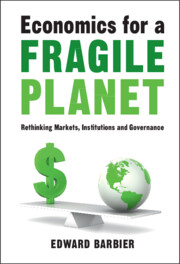Book contents
- Economics for a Fragile Planet
- Economics for a Fragile Planet
- Copyright page
- Dedication
- Contents
- Figures
- Tables
- Preface
- Acknowledgments
- 1 Introduction
- 2 Humankind and the Planet
- 3 Economics for a Fragile Planet
- 4 Climate Change
- 5 Land Use Change and Biodiversity
- 6 Freshwater
- 7 Oceans and Coasts
- 8 Public Policies
- 9 Business
- 10 Conclusion
- References
- Index
1 - Introduction
Published online by Cambridge University Press: 24 March 2022
- Economics for a Fragile Planet
- Economics for a Fragile Planet
- Copyright page
- Dedication
- Contents
- Figures
- Tables
- Preface
- Acknowledgments
- 1 Introduction
- 2 Humankind and the Planet
- 3 Economics for a Fragile Planet
- 4 Climate Change
- 5 Land Use Change and Biodiversity
- 6 Freshwater
- 7 Oceans and Coasts
- 8 Public Policies
- 9 Business
- 10 Conclusion
- References
- Index
Summary
In a world of growing environmental risks and ecological scarcities, ensuring a safe Anthropocene for humankind is essential. This introductory chapter outlines five key principles of an "economics" for a fragile planet: ending the underpricing of nature; fostering collective action; accepting absolute limits; attaining sustainability; and promoting inclusivity. Each of these five principles is briefly outlined in this introductory chapter, which are the building blocks for new thinking on economics and policies for an increasingly fragile world. The aim of this book is to explain what this “economics for a fragile planet” might look like. This chapter ends with a brief overview of how each subsequent chapter tackles this challenge.
Keywords
- Type
- Chapter
- Information
- Economics for a Fragile PlanetRethinking Markets, Institutions and Governance, pp. 1 - 20Publisher: Cambridge University PressPrint publication year: 2022

